M.2 NVMes Use as Storage Pools Coming to Synology NAS and DSM
EXCELLENT news for anyone that has been following the Synology NAS platform and DSM for the last few years, with the apparent reveal that Synology are intending to officially allow the use of M.2 NVMe SSDs as Storage Pools on their newest generation of Diskstation devices. Now, although all of the information on this feature arrives from official Synology sources, it is worth highlighting that the brand has now completely spelt out the details yet! Right now, it would appear that the newest release from Synology, the DS923+ Diskstation NAS (Read my full review on the DS923+ HERE), which arrives with two 2280 M.2 NVMe SSD Bays, has the potential to use these storage bays for both areas of SSD Caching AND Storage Pool use. Now, this is a feature that long-term Synology NAS followers have been requesting right the way back since 2017/2018 with the launch of the DS918+ (their first system to introduce M.2 NVMe SSD Bays). So, before we go into the how’s and when’s, let’s quickly discuss why this is SUCH a big deal.
UPDATE – 17/11/22
Synology has updated its knowledge center pages, regarding m.2 NVMe SSD Bays and using them as Storage Pools. As it stands, ONLY the Synology DS923+ NAS is listed.
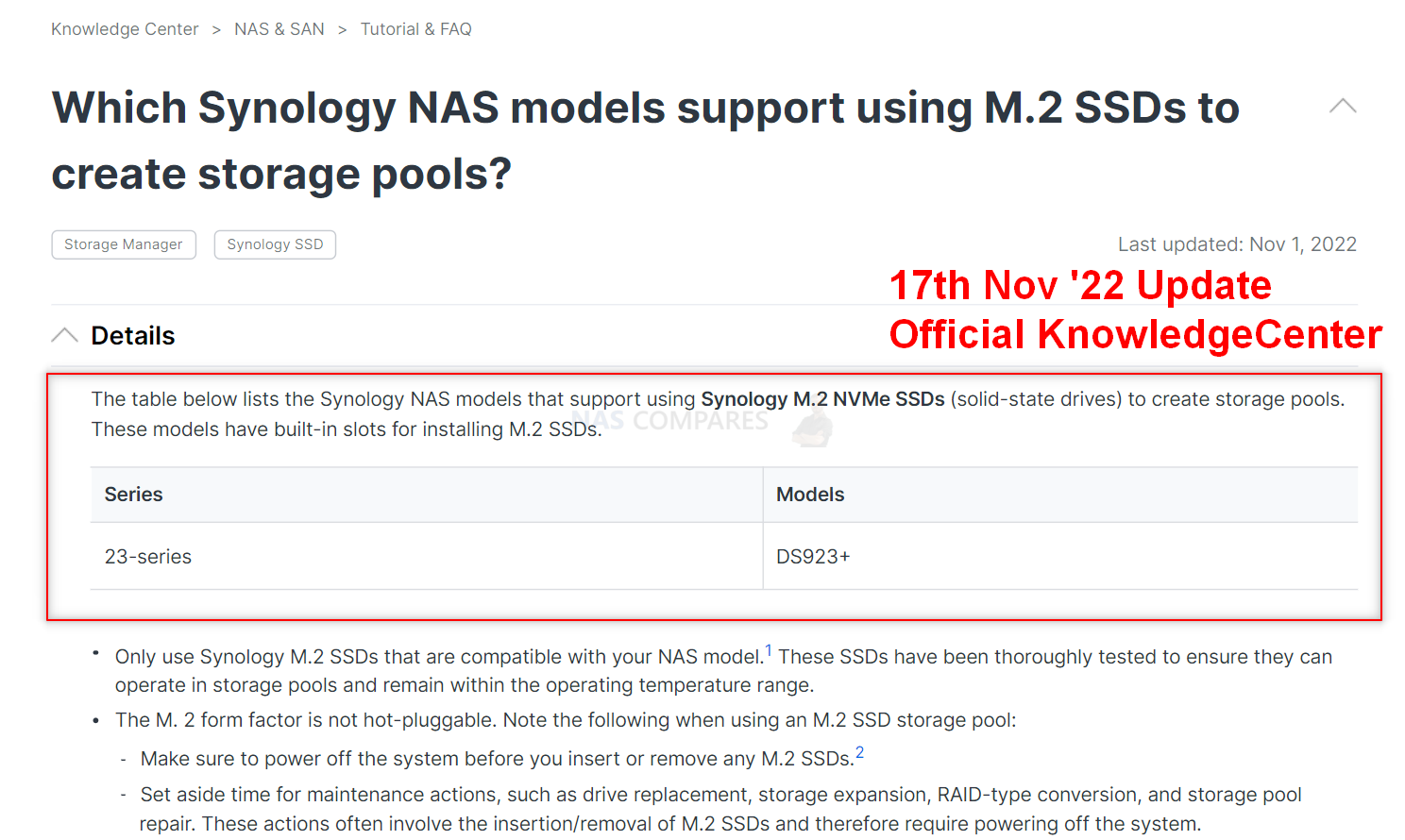
The full details can be found on this page here.
(Back to Original Article)
Why is m.2 NVMe SSDs as Storage in Synology NAS a Big Deal?
As mentioned, Synology has been producing Diskstation and Rackstation systems with M.2 NVMe SSD bays inside (as well as via upgrade cards such as the E10G20-T1 and M2D20) for quite a few years now, but has officially restricted their use for caching only. SSD Caching allowed users to use the benefits of the significantly faster M.2 NVMe SSDs to benefit the slower, but larger and more affordable Hard drives in a larger RAID configuration. This was done via write caching (introducing a writing layer of SSD to speed up data being sent to the larger storage array) and/or read caching (which copied more frequently accessed data, small scale, to the SSDs to speed up it’s retrieval as regular requests were made by client(s) systems). As good as all these sounds, there was certainly a % of users that resented spending often 4-5x the cost per TB (compared with HDDs) on M.2 NVMe SSDs, but not be able to use them for much after storage pools for hot data, specific service/app/database storage and/or just generally be able to use this storage space the way they could with HDDs.
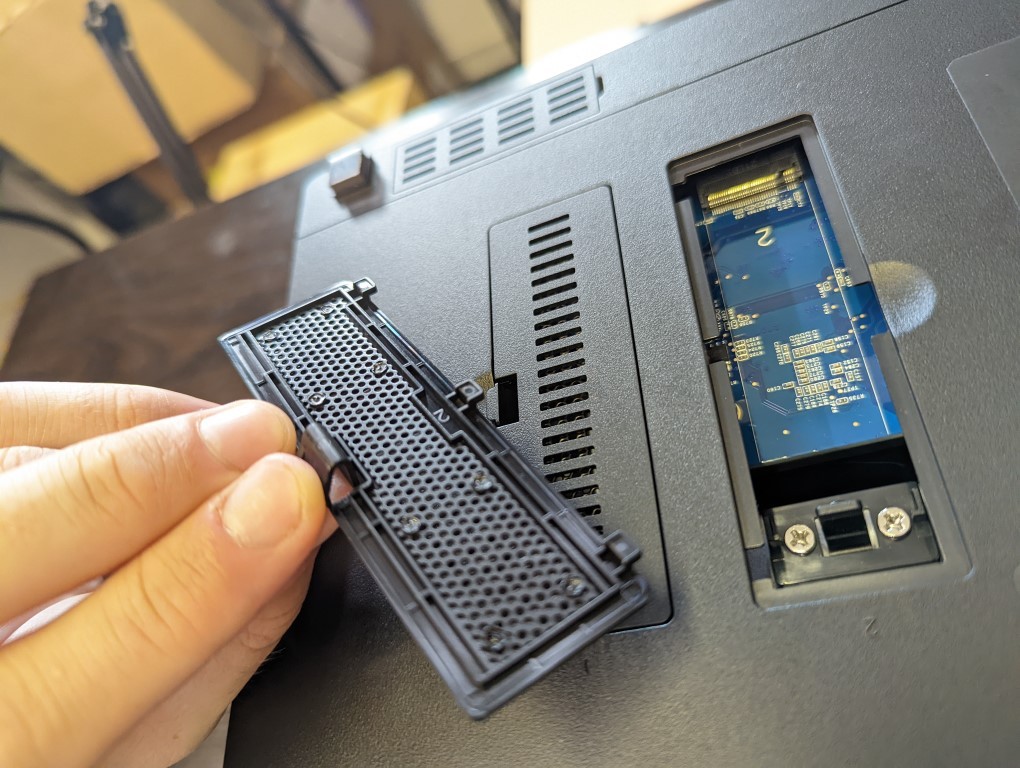
Being able to use these PCIe-based SSDs for storage pools opens the doors to a large number of benefits. First off, with 10GbE and 10GbE-upgrades becoming increasingly available on the Synology NAS hardware in 2022/2023, users can take advantage of the larger bandwidth speeds available in these SSDs externally in a way that they couldn’t before (even the most affordable PCIe Gen 3 M.2 NVMes will give you performance in the 1000MB/s). Additionally, users who want to run specific applications and services as fast as possible will be able to store their data on these SSDs, improving performance and lowering latency substantially compared with their storage on slower HDDs (even when in RAID arrays in most cases) thanks to the SIGNIFICANTLY higher IOPS ratings of these drives. It is worth noting that other brands have introduced M.2 NVMe SSD use as storage pools already, so this is not new as a concept. Additionally, many users have been unofficially using the M.2 NVMe SSD Bays for storage till now via the use of github patches and/or specific SSH commands (something that might be a concern if this feature becomes widely available and possibly harming their unofficial NVMe SSD pools). But all this aside, it is just fantastic that this feature is coming to Synology NAS and DSM.
Synology Official State M.2 NVMe SSD Use as Storage Pools, DS923+ NAS
References to M.2 NVMe SSDs being used as Storage Pools have arrived thanks to the release and documentation surrounding the Synology DS923+ NAS today (already noticed by a user on reddit – fair play to them!) and more specifically in three areas. The first is on the official Synology DS923+ NAS product page:
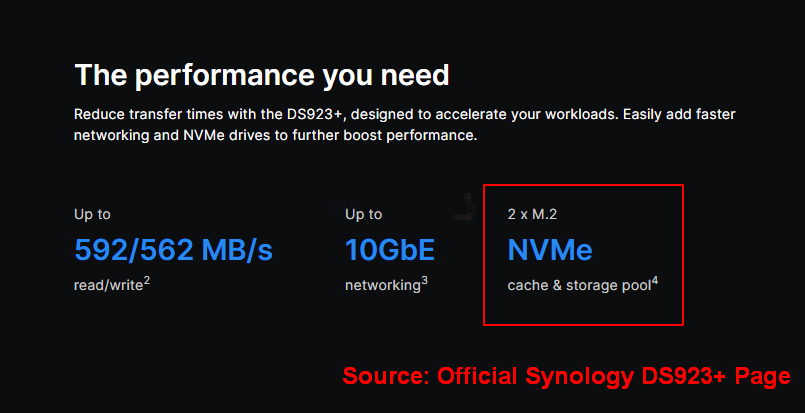
The next reference is on the official Synology Performance charts for the DS923+ NAS, showing that there were tests performed on an SMB 10GbE setup, with two 400GB SNV3400 Synology NVMe SSDs, via a 10GbE network protocol. Performance stats showed that the Rad speed largely saturated the connection at 1,179MB/s, but Write speed was a pinch under, at 772.84MB/s. However, it is worth remembering that the Synology SNV3400 is a drive that prioritizes Read speed and was chiefly designed for read caching. So, a much more Read/Write balanced drive will likely do better. Additionally, even if you pooled the drives into a RAID 0 or 1, the DS923+ NAS only has a single external 10GbE port option (via E10G22-T1-mini Upgrade).
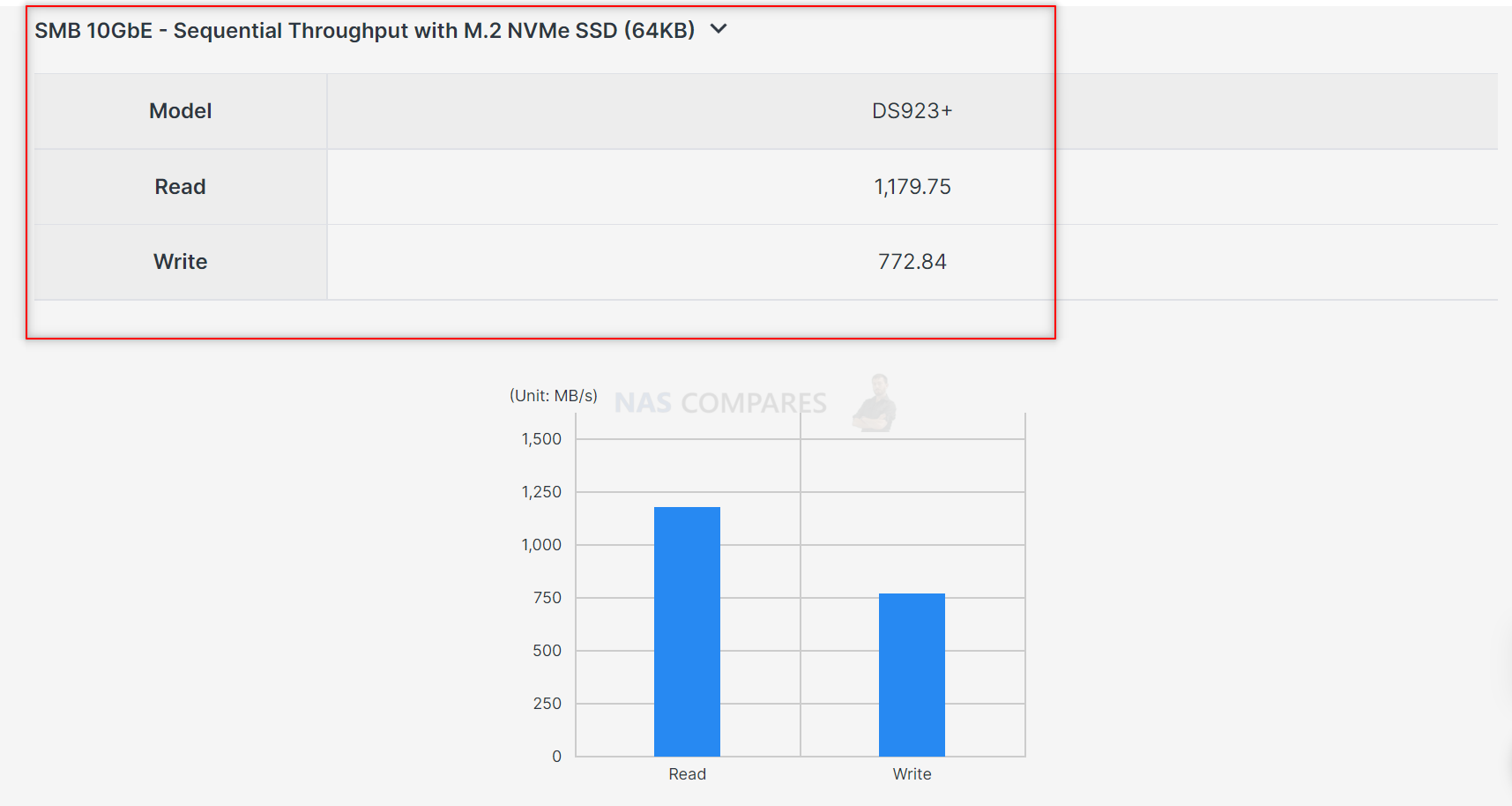
Finally – and this one REALLY surprised me – but the official Synology DS923+ NAS press release states that the DS923+ NAS supports the M.2 NVMe SSDs can be used for fast caching or to create additional all-flash storage pools. So, that pretty much sews the whole thing up! But, I should add that things are almost certainly not as clear-cut as that! Let’s discuss which Synology NAS will support this feature and the potential hurdles ahead.

Will M.2 NVMe SSD Storage Pools Be Possible on ALL Synology NAS Drives?
Now the fact that the Synology DS923+ NAS online resources state that the NVMe SSD Bays can be used for M.2 NVMe SSD storage does NOT mean that ALL Synology NAS with these bays will support this feature. In previous years, when I have discussed this feature with Synology team members at events, they have always been pretty clear on this. They did not want to enable this feature on systems that did not provide the hardware and/or bandwidth to support its full use. So, for example, the DS918+ and DS920+ (which both feature M.2 NVMe SSD Bays) are built on PCIe Gen 2 architecture, whilst most M,2 NVMes available right now commercially are either PCIe Gen 3 or Gen 4. Synology HAS released several PCIe3 NAS’s in the last 1-2 years with M.2 SSD bays (such as the AMD Emb.Ryzen powered DS1621+, DS1821+, and DS1621xs+), but for whatever reason, the feature was still not made available (perhaps because the available lanes were spread too thinly and the bays are perhaps PCIe 3 x2 – That’s not a blanket statement, just a hypothesis. PCIe Generation increases the bandwidth. To massively oversimplify it a bit, PCIe 2 is 500MB/s and PCIe 3 is 1,000MB/s, and the x2, x4, X8 etc figure is a multiplier. So a PCIe 2×2 = 1,000MB/s, whereas PCIe 3×4 = 4,000MB/s. ALL of these numbers are potential maximum bandwidth (i.e the pipe which the SSD can try to fill) and do not factor in a whole bunch of dual-lane architecture stuff, but the gist is pretty much there. Remember, although I mentioned earlier about external performance (i.e 10GbE networking), the only internal limitations for apps, data and services are the PCIe Lanes afforded to the M.2 bays and the CPU+Memory inside the system. The more bandwidth and horsepower the NAS has, the BETTER the results and then you are talking big performance numbers!
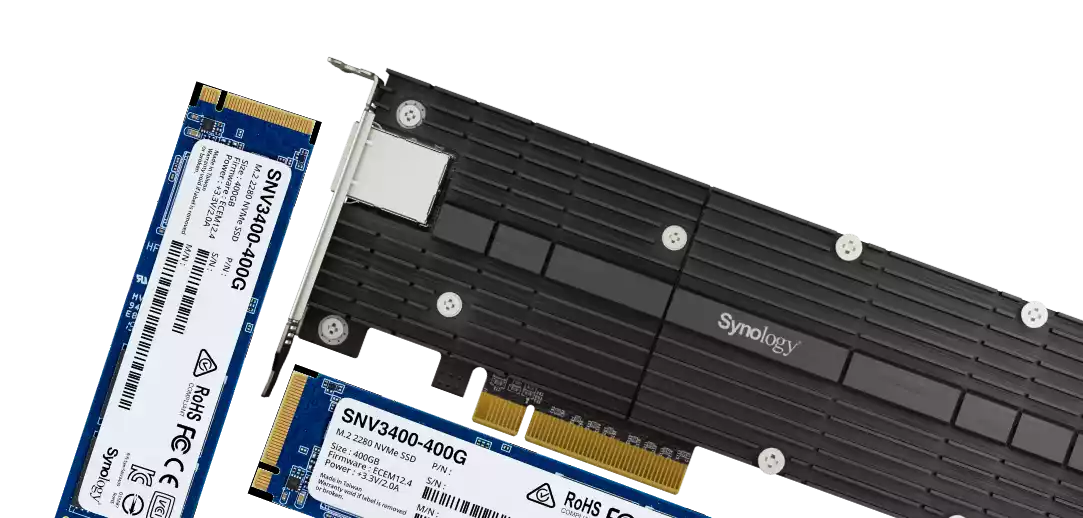
So, if the above holds true and Synology is only providing this feature to NAS systems that have M.2 NVMe SSD bays that are Gen 3, then systems like the DS920+ and DS720+ are not going to support this, or IF they do have it enabled, you might not get the full intended benefits internally (plus they lak any greater than gigabit external connectivity). So, NAS’ such as the DS1522+, DS923+, DS723+ NAS will have NVMe SSD Storage Pool use enabled, and NAS’ with PCIe Gen 3×8 card upgrade slots (i.e the DS2422+, DS3622xs+, RS822+, etc) will likely have the support too, down the line (though, it is still unconfirmed about whether the E10G20-T1 or M2D20 NVMe SSD cards have any kind of fixed architecture to allow this. In my review of the Synology DS923+, I was unable to test this feature, as it was seemingly unavailable on the firmware update I was running (possibly resolved with a day 1 launch DSM update – however MY other blog review and YouTube content is in production with prevents testing of this feature right now being possible. As soon as those are completed, I will get this tested to see if 1) the feature is indeed available on the DS923+ NAS right now, and 2) if there are any limitations towards using non-Synology branded SSDs in these bays for this feature. At the time of writing, the latest patch/release notes for DSM 7.1 on the DS923+ NAS do not show further information, but expect more noise on this very soon, I am sure! Cheers for reading!
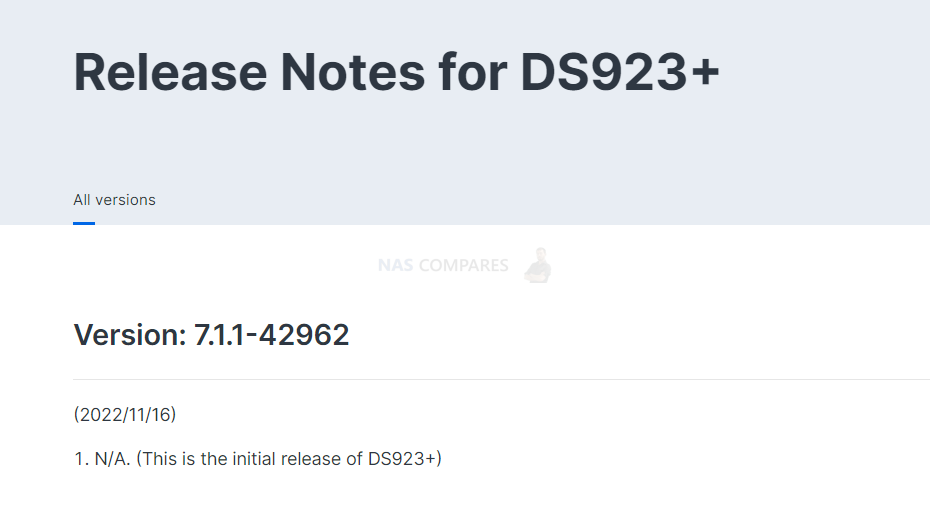
Need More Help Choosing the right NAS?
Choosing the right data storage solution for your needs can be very intimidating and it’s never too late to ask for help. With options ranging from NAS to DAS, Thunderbolt to SAS and connecting everything up so you can access all your lovely data at the touch of a button can be a lot simpler than you think. If you want some tips, guidance or help with everything from compatibility to suitability of a solution for you, why not drop me a message below and I will get back to you as soon as possible with what you should go for, its suitability and the best place to get it. This service is designed without profit in mind and in order to help you with your data storage needs, so I will try to answer your questions as soon as possible. We pool the comments on this article and the videos that are featured in it to keep all the relevant comments in one place, so take a look and see if your POV is the same as everyone else’s.
📧 SUBSCRIBE TO OUR NEWSLETTER 🔔
🔒 Join Inner Circle
Get an alert every time something gets added to this specific article!
This description contains links to Amazon. These links will take you to some of the products mentioned in today's content. As an Amazon Associate, I earn from qualifying purchases. Visit the NASCompares Deal Finder to find the best place to buy this device in your region, based on Service, Support and Reputation - Just Search for your NAS Drive in the Box Below
Need Advice on Data Storage from an Expert?
Finally, for free advice about your setup, just leave a message in the comments below here at NASCompares.com and we will get back to you. Need Help?
Where possible (and where appropriate) please provide as much information about your requirements, as then I can arrange the best answer and solution to your needs. Do not worry about your e-mail address being required, it will NOT be used in a mailing list and will NOT be used in any way other than to respond to your enquiry.
Need Help?
Where possible (and where appropriate) please provide as much information about your requirements, as then I can arrange the best answer and solution to your needs. Do not worry about your e-mail address being required, it will NOT be used in a mailing list and will NOT be used in any way other than to respond to your enquiry.

|
 |
| Where to Buy a Product | |||
|
|
    
|

|
VISIT RETAILER ➤ |
 |
    
|

|
VISIT RETAILER ➤ |
We use affiliate links on the blog allowing NAScompares information and advice service to be free of charge to you. Anything you purchase on the day you click on our links will generate a small commission which is used to run the website. Here is a link for Amazon and B&H. You can also get me a ☕ Ko-fi or old school Paypal. Thanks! To find out more about how to support this advice service check HERE
Gl.iNet Flint 4 10G+2.5G Router Revealed @CES 2026
EVERYTHING NEW from Minisforum @ CES 2026
Gl.iNet Slate 7 PRO Travel Router (and Beryl 7) REVEALED
Minisforum N5 MAX NAS - 16C/32T, 128GB 8000MT RAM, 5xSATA, 5x M.2, 2x10GbE and MORE
The BEST NAS of 2026.... ALREADY??? (UnifyDrive UP6)
How Much RAM Do You Need in Your NAS?
Access content via Patreon or KO-FI
Discover more from NAS Compares
Subscribe to get the latest posts sent to your email.


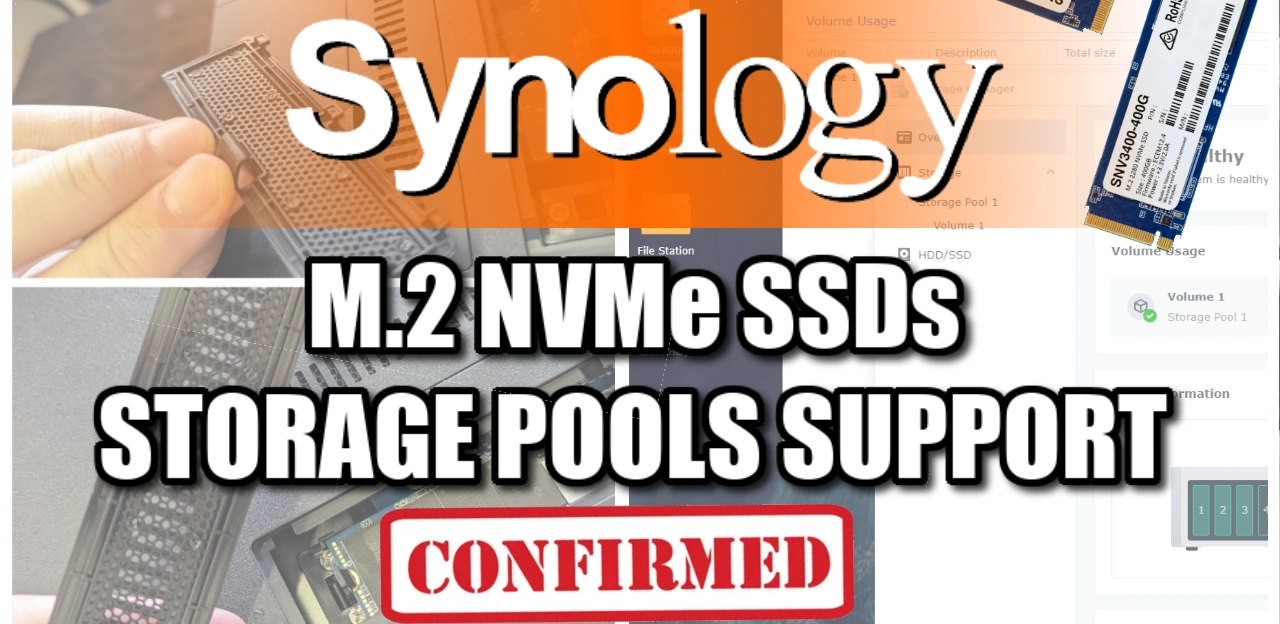




Hi, I currently have the DS716+II plus expansion bay with raid 5. 3 x 8tb and and 4x 4tb drives . I plan to purchase the 923+ with the 10gbe network card. I am wondering is it worth buying the nvme ram for to speed up access and to stop buffering. Mainly use it for streaming my music but have video files also. Your views would be appreciated.
REPLY ON YOUTUBE
Do you think they’ll change their stance re non synology M2 drives?
REPLY ON YOUTUBE
does the nvme increase boot speed?
REPLY ON YOUTUBE
are they pcie gen 3 x4 or x1?
REPLY ON YOUTUBE
Thx for this video today ssds became really cheap compaired to 1 year ago
REPLY ON YOUTUBE
So I do unreal engine stuff and need like 2 8tb on m.2 pci5 12gb/s available and 48tb on hard drive that I can drag back and forth to work on whenever I change projects. Can you make that video????? thank you love your work.
REPLY ON YOUTUBE
Does this work on 720 +
REPLY ON YOUTUBE
good video but unnessary streched
REPLY ON YOUTUBE
Is there a NAS that has only nvme/m2? I just hate spinning disks and a NAS with m2 would be soooo much smaller and faster.
REPLY ON YOUTUBE
Hello Brother. I understood that Synology approved for use only its SSD/NVMe model, but in practice can I use it on 1522+ brands like WD SN770 or Kingston FURY?
REPLY ON YOUTUBE
Noooo no NVMe storage pools for my 1019+ 🙁
REPLY ON YOUTUBE
Does it support samsung 970 evo m2 for storage pools?
REPLY ON YOUTUBE
Can you repeat all of that in English now?
REPLY ON YOUTUBE
Is there any update on whether this is coming to the 920+? I”ve just bought one and considering returning it…
REPLY ON YOUTUBE
If (just) serving up and backing up files, do synology nas NVME cache benefit from uber speed (7k MB/s) vs. 5k or 3.5k?
REPLY ON YOUTUBE
Give me a Synology NVME only NAS!
REPLY ON YOUTUBE
3:03 a few hundred what?!?
REPLY ON YOUTUBE
Interesting news! Does this work exclusively with Synology M2 drives or can I use other M2 drives and use them as volumes?
REPLY ON YOUTUBE
Thanks! I’ve gone through a myriad of sites to gain an understanding of available NAS options, and your site is THE ONLY site I’ve found that will allow me to spec out the components of my NAS properly – in other words, the confidence to “know” that what I “think” I know about the service levels I’ll receive from my NAS, is actually what I “know” I’ll receive from that NAS. Nothing worse than knowing that what you thought you knew, you now know you didn’t really know. (unless you’re inventing a new light bulb or something). Marketing brochures only get you so far…
REPLY ON YOUTUBE
@nascompares Now that DSM supports M2 for storage and cache is it possible to do both at the same time? E.g. put 2x4TB in the DS923 and use 4TB for cache and 4TB for data storage? Both in mirrored partitions
REPLY ON YOUTUBE
So does this mean instead of the 2.5 or 3.5 HDD drives bays for storage , we will be able to use NVME m.2 SSDs for faster storage speeds ? Or is it just casheing? So is this a new NAS system enclosure they will be releasing or is this a current model that will get a update ? I’m confused . Sorry I’m new to this,
REPLY ON YOUTUBE
Interesting, as I was just looking into getting a NAS after my external classic HDD is taking too long to get going. Anyhow, the first thought I had was, “Can I use m.2 drives to make a NAS even faster?” Turns out – NO. Next thought was, “How about using an adapter from m.2 to SATA?” That said, is that not an option? Thanks.
REPLY ON YOUTUBE
Thank you! Is there good Nas that fits only SSDs?
REPLY ON YOUTUBE
Says my kingston m.2’s are not compatible, so cannot initialize them. Only the expensive synology 400 and 800GB are on their compatibility list. Is there a workaround?
REPLY ON YOUTUBE
I’ve been using an NVME storage pool on my DS918+ for nearly two years now — which needs some command line volume creation — which is absolutely brilliant for VMM and Docker use.
REPLY ON YOUTUBE
Is it also available for DS3018xs? It has PCIe expansion card for adding 2 M.2 NVMe drives. Would I be able to create RAID 1, if buy the Synology branded M.2 expansion card?
REPLY ON YOUTUBE
Does NVME Storage Pool works via Synology NVME Drives? Can I put Samsung or Crucial NVME Drives in it?
REPLY ON YOUTUBE
I just read your article about this. Thanks for testing! Storage pools only availble if you use the overpriced Synology SSDs and even if you do so, no possibility to use them as boot drive for DSM. Overall the DS923+ is a joke and partial downgrade to the DS920+. Even the CPU seems to be slower despite consuming more power since it’s only a dual core while the J4125 is a quad. Synologys policy reminds me of Apple.
REPLY ON YOUTUBE
քʀօʍօֆʍ
REPLY ON YOUTUBE
that would be really awesome and also could justify use of 10Gbe on smaller (less bays) NASes,
NVME SSD offer superior performance even on 1Gbe with tons of small files operations indeed 🙂
REPLY ON YOUTUBE
you give such great info thank you so much.
REPLY ON YOUTUBE
you give such great info thank you so much.
REPLY ON YOUTUBE
Too bad I own a 918+… However, I wish in the future we are offered super compact NAS system (the size of an old VCR cassette or even a cigarette pack) with only NVME slots (4 or 8) and one or two 10Gbe ETH ports. It’s not only about performance: I need a 100% silent NAS. And also an extremely low power comnsumption one. In a couple of year it’s possible SSD drivers are going to cost the same as mechanical ones, per TB. When 16TB NVME are out, I think mechanical disks are dead.
REPLY ON YOUTUBE
Until now, I have no NAS, so please forgive this silly question, but wouldn‘ t it make sense to install DSM for better performance on a SSD?
Could the M.2 NVMe storage on Synology an option to run DSM on it?
REPLY ON YOUTUBE
PCI-x Gen2 has 2Gbit per second bandwidth, and that is a million miles beyond any sniping rust speed, not to mention IOPS. So there is no reason for Synology not to enable this in DS920+, but greed (if you want it buy new hardware).
REPLY ON YOUTUBE
It’s not a bottleneck if they enable it on 920+. There is no way to get connection to these NASes that exceeds 2GB/s 🙂
REPLY ON YOUTUBE
It’s not a bottleneck if they enable it on 920+. There is no way to get connection to these NASes that exceeds 2GB/s 🙂
REPLY ON YOUTUBE
Honestly the PCI-E gen 2 argument is kind of moot; sure it won’t give you the full bandwidth of the SSD… but at the same time, it would still not be bottlenecked on things like VM’s or other docker containers, it’s still worthwhile having. I’m more interested as to whether you can use the solid state drive with multiple partitions; having a mix of storage and caching by using a relatively large drive.
REPLY ON YOUTUBE
Which NAS do you recommend for complete noobs who just want to backup and synchronize data from their desktop pc and Android phone? Want it to be simple like drop box.
REPLY ON YOUTUBE
Thks
REPLY ON YOUTUBE
Ryzen R1600 , Why would they use this Chip ?
Chip came out in Feb 2020, I can’t find Price for Ryzen R1600 , If someone can find the Chip Price I am sure it would be cheap by now.
Please Post the Price,
I bought a 1522+ Installed 10Gb Network card , I like the box doing Backups no Plex so Graphics not hurting me , HyperBackup across VPN to another Synology Box
30+ Workstations Bare Metal , 40 Mailbox Backups, What helped I bought 2x 2TB NVME Gen 3 Crucial drive, in a Read Write Configuration. Number of Files is 15 Million + takes a awhile to count these files. I have it hooked up to Netgear 10,5,2.5.1 Switch. Server has 10GBNics Workstation 2.5Gbe Standard with Workstations now. Even Lowest Intel Nucs have 2.5GB Network cards.
Even with this I don’ use 4GB Max Ram on This Box Comes with 8GB ECC Ram. Why use faster Chip , I just see Synology trying to save $$ on Hardware. Can this box Max out
Hard drives not sure. When I backup my VMware Server for Incremental takes about 2.5 mins.
People cry about this not being fast enough . I am happy with the 1522+ , I looks like you could have 2x 10GbE if Synology wants to.
Is Qnap ahead in some ways yes they are in the Hardware side , Before Synology I used Qnap Worried about Security on Qnap.
Ryzen R1600 Last Time Buy 2029 from AMD So this chips will be around for sometime in the future for Synology. I would say at least another 3 years , then 3 years later maybe for the low end Synology boxes that will come in the future .
Comments Welcome
Specs Below
Ryzen Embedded R1600 is a mobile processor with 2 Cores, launched in February 2020. Embedded R1600 on a 14 nm production process TDP of 25 W , SoC Features
Ethernet: 2x 10GbE
USB: 2x USB 2.0, 4x USB 3.1 Gen2
SATA: 2x SATA3
Ethernet 2x 10GbE
PCIe® Lanes 8L Gen3
TDP 12–25W
REPLY ON YOUTUBE
Is that a D-Link 6-Port 10GB & 2.5GB Unmanaged Gaming Switch in the background? did you guys do a video on it? would love one if you didn’t
REPLY ON YOUTUBE
????????????????????????????????????????????
REPLY ON YOUTUBE
Would love a DS0+ 2 NVMEs!
REPLY ON YOUTUBE
Looking forward to being able to use Samsung 990 Pro Gen 4 SSD’s in my Synology web server!
Just wish I could get a decent CPU in an affordable system to handle the web hosting I do with mine… Thanks for the great videos…
REPLY ON YOUTUBE
Need for DS918+
REPLY ON YOUTUBE
Hope my old DS918+ will be compatible with this. Thanks for the video mate.
REPLY ON YOUTUBE
Great job covering some of the possible Synology created pitfalls. Anyway, this gives some (a little) purchase to Syno’s push for 10GbE over 2.5GbE in its offerings (I still think they should have had 2.5GbE for consumer models).
REPLY ON YOUTUBE
It seems that users of Synology NAS devices have also finally had their time ???? I’ve been using M.2 NVMe modules on QNAP NASes in RAID as very fast data volumes moreover for VM (+ GPU) for many years now, and as I watch, I’m glad I switched to QNAP. Still waiting a few years for Synology to introduce something is quite a hassle ????
REPLY ON YOUTUBE
from a tech standpoint there is no reason not to enable pci-e gen 2 bays for storage.
pci-e gen 2 offers 2gb bandwith, (net a bit less of course) but that is still 10 times faster than sequential read/write of hdds.
nvme-disks may offer a bit higher sequential read and write in theory but for one you cannot utilize that speed even with a 10gbit connection and even if you could, you will tax the ryzen r1600 quite a bit with a maxed out pci-e gen3 raid setup. the chip is much more capable than the celerons before when it comes to io, but it still is only 2core/4threads at fairly moderate clock speeds.
in practice there is very little advantage for this kind of hardware between pci-e gen 2 and gen 3. what we really want are the iops and those are not hindered by pci-e gen2.
load times will be greatly improved and with this announcement a tiny windows vm that does not require a lot of compute but profits of fast disk access becomes a real possibility combined with the up to 32gigs of ram. imagine a small business that runs e.g. the accounting database for shared access on a 923+ (i’d have loved to have seen the 4core 8 thread amd chip for that very reason, it would have made this from a good into a great soho setup).
REPLY ON YOUTUBE
Really exciting! Great video, as always! I think with PCIe gen 5 becoming mainstream (4GBps per lane!) it would be cool to see what that would mean for all-NVME NAS builds. Even a relatively modest 16 PCIe5 lane slot could theoretically support 16 drives at “ok” speed or 8 drives at excellent speed, and that’s not even counting M.2 slots built into the board!
REPLY ON YOUTUBE
Another strange decision from Synology. This will annoy far more than it impresses because those that want this but need more drive slots will be left out and those who have recently bought other high end systems will be screwed over.
REPLY ON YOUTUBE
Personally, I’m ripe to upgrade my 5 year old NAS, but I’m waiting for a truly modernized NAS product. By this I mean, a NAS chassis not built to accommodate 3.5”drives at all. I want a new NAS that only uses smaller, next gen devices such as NVMe SSDs, the benefits being a much smaller box, and correspondingly lower power use, noise, and heat.
However, NAS makers seem to move pretty slow. It could be awhile.
REPLY ON YOUTUBE
Hopefully it does come to my 1520+ but if not oh well, its been such a rock solid NAS and does everything I need and I still have no plans to replace it.
REPLY ON YOUTUBE
Now lets hope for a 8 bay rackstation with a few nvme slots and 10gbe > Rs1223+
REPLY ON YOUTUBE
Having created another storage pool on NVME through SSH on a DS1019+ in the last 3 days (51 hours uptime) it provides a massive boost to Docker and VM’s even on PCIE 2.0. I look forward to it being native in DSM 7.2 even if it is not directly supported on my model.
REPLY ON YOUTUBE
this is great news. what about DS-1621+ and 1821+ PCIe slot NVME option ?
REPLY ON YOUTUBE
The way they’ve ignored what other NAS makers were doing with NVMe is yet another example of Synology embracing technology to the point where it makes little sense. It may be that they’re noticing a downturn in sales that forces them to act.
That they still use ESATA for external storage connections, won’t provide 2.5GbE as a standard LAN port and insist on Synology branded upgrades (when they don’t make drives, NVMe or RAM) makes me wonder if its domination of the NAS market is destined to end abruptly.
That they might not support older NVMe capable machines with the storage upgrade smacks of a company that is overconfident in its ability to dictate to the customers what the future will be.
REPLY ON YOUTUBE
Not being able to use SSDs for Storage Pool is one of the 2 reasons I’m avoiding Synology (the other being the HDD compatibility story). It’s nice to see they’re (seemingly) fixing this.
REPLY ON YOUTUBE
???? – NЕW А DАТING FОR АLL ТАSТЕS & АGЕS ????????y????
REPLY ON YOUTUBE
Shame it cant go in my 920+.
REPLY ON YOUTUBE
*Note* – I have only JUST uploaded this video! Youtube takes a while to process in 720P and 1080p (15+ mins). So if you are only seeing this in low quality, come back in a bit and it should be at full HD quality soon! Thanks for watching!
REPLY ON YOUTUBE